Frequently Asked Questions
- Veteran Owned & Operated
- Energy-Efficient HVAC Solutions
- Licensed & Certified Technicians

Air Conditioning
How do I know when to replace my air conditioner?
Consider replacing your AC if:
- It’s more than 12-15 years old and inefficient.
- Your energy bills keep increasing despite maintenance.
- You’ve had multiple costly repairs in recent years.
- Your home has uneven cooling or humidity issues.
- Your AC unit runs constantly or struggles to keep up.
A new energy-efficient AC system can lower utility bills and improve overall home comfort.
What is SEER and why does it matter?
SEER (Seasonal Energy Efficiency Ratio) measures how efficiently an air conditioner cools your home. A higher SEER rating means better energy efficiency and lower cooling costs. Modern AC units typically have SEER ratings of 14 to 22, with higher ratings offering greater savings over time.
Why is my AC blowing warm air?
If your air conditioner is blowing warm air, it could be due to:
- Low refrigerant levels (possible leak)
- Dirty air filter blocking airflow
- Thermostat settings incorrect (ensure it’s set to “cool”)
- Frozen evaporator coils due to restricted airflow
- Compressor or capacitor issues
What are the benefits of an energy-efficient AC?
Lower energy bills, improved cooling performance, and a reduced carbon footprint.
How long does AC installation take?
Most installations are completed within a day, but complex setups may take longer.
Furnace
How often should I schedule furnace maintenance?
It’s recommended to schedule furnace maintenance once a year, ideally in the fall before the heating season begins. Regular maintenance helps prevent breakdowns, improve efficiency, and extend the lifespan of your furnace.
What should I do if my furnace stops working?
First, check your thermostat settings, circuit breaker, and air filter. If everything seems normal but the furnace still isn’t working, contact a professional for furnace repair services.
Why does my furnace keep turning on and off frequently?
This issue, known as short cycling, can be caused by a dirty air filter, thermostat issues, or an oversized furnace. A professional technician can diagnose the cause and make the necessary adjustments.
How can I improve my furnace’s efficiency?
To improve furnace efficiency, you can:
- Schedule annual maintenance
- Replace air filters regularly
- Seal air leaks around doors and windows
- Install a programmable thermostat
- Keep vents and registers clear of obstructions
Why is my furnace making loud noises?
Strange noises like banging, squealing, or rattling could indicate issues with loose components, a failing blower motor, or ignition problems. It’s best to have a professional inspect the system before the issue worsens.
When should I replace my furnace instead of repairing it?
If your furnace is over 15 years old, requires frequent repairs, or struggles to heat your home efficiently, it may be more cost-effective to replace it with a newer, energy-efficient model.
What are the signs that my furnace needs repairs?
Common signs that your furnace may need professional repairs include:
- Uneven heating or cold spots in your home
- Unusual noises such as banging or rattling
- Increased energy bills without explanation
- Frequent cycling on and off
- Weak airflow from vents
How long does a furnace typically last?
A well-maintained furnace can last between 15 to 20 years. Regular maintenance and timely repairs can help extend the lifespan of your unit.
How often should I replace my furnace filter?
It’s recommended to replace your furnace filter every one to three months, depending on factors like indoor air quality, pet dander, and how often your system runs. A clean filter improves efficiency and helps maintain good air quality.
What is 2-stage Furnace?
A 2-stage furnace is a heating system that operates at two different levels of heat output, unlike a traditional single-stage furnace that only runs at full capacity. This allows for better efficiency, improved comfort, and more consistent indoor temperatures throughout your home.
How Does a 2-Stage Furnace Work?
- Low Stage: Most of the time, the furnace runs at a lower heating capacity (around 60-70% of full power). This helps maintain a steady, comfortable temperature without excessive energy use.
- High Stage: When temperatures drop significantly and more heat is needed, the furnace automatically switches to full capacity to keep your home warm.
Mini-Split
What is a ductless mini-split system?
A ductless mini-split AC system is a compact and energy-efficient cooling solution that doesn’t require ductwork. It consists of an indoor air handler and an outdoor condenser unit, providing zoned cooling for specific areas or whole-home comfort. Mini-splits are ideal for additions, garages, or homes without central HVAC systems.
